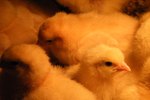
The relatively small sexual organs of a parakeet are covered by a tremendous amount of feathers. This makes visual determination of gender based on anatomy difficult. While nature does provide other visual clues via color and behavior, the only foolproof way to find out if your bird is a male or female is to run DNA test on feathers or a blood sample. An avian veterinarian can send samples to a reputable laboratory.
Color
Birds must first reach sexual maturity before this method of gender identification is applicable, according to Pet Informed. However, between 8 and 12 months of age, the band of raised skin across the top of a parakeet's beak (called the cere) takes on a gender-specific color. Males take on a bright blue or rich violet while females take on a variation of brown, anywhere from a rich brown resembling that of oiled leather to a light tan. In some rare instances, a female's cere will turn a very pale blue with a whitish tint. This bluish tint will dramatically lighter than that of a male, making sex determination visually obvious. The same sex hormone responsible for cere color causes color variation on the legs: males have blue legs; females have brown legs, sometimes with a pinkish tint.
Behavioral Differences
Bird Tricks tells us that male and female parakeets tend to behave differently. While the site cautions that behavioral differences alone are not sufficient for determining gender, it does indicate that bird experts consider behavioral differences a strong indicator. Male parakeets display more head bobbing and singing, and are more active in their cages and social with other birds as well as humans. Female parakeets tend to be bossy toward others and louder in their vocalizations, but to refrain from singing.
Baby Clues
While cere color is an indicator later on in life, the website God's Creatures states that a closer look at the ring directly surrounding the nostril can give clues to a parakeet's gender even at a very young age. Female baby parakeets tend to have a white ring around the nostril; males tend to have a nostril ring with a pink or purple tint. Unfortunately, these tints are often very difficult to distinguish when a bird is less than a month old.
Biting Habits
The biting habits of young parakeets is also a possible indicator of gender, according to God's Creatures. A baby parakeet who bites hard and won't let go is likely a female showing her bossy tendencies. A baby parakeet who nibbles playfully is most likely a male practicing his social skills.
Egg Laying
This is another potential indicator that requires waiting for the bird to reach maturity. However, if you are finding eggs in your bird's cage, she is definitely female! Pet Informed cautions against assuming the absence of eggs means your bird is a male, though; females often do not lay eggs.
References
Photo Credits
-
BananaStock/BananaStock/Getty Images
Writer Bio
Amy M. Armstrong is a former community news journalist with more than 15 years of experience writing features and covering school districts. She has received more than 40 awards for excellence in journalism and photography. She holds a Bachelor of Arts in communications from Washington State University. Armstrong grew up on a dairy farm in western Washington and wrote agricultural news while in college.



